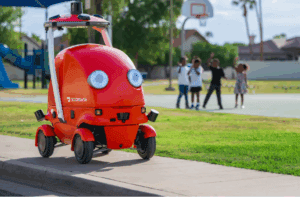 On September 30, 2025, DoorDash introduced Dot, an autonomous electric delivery robot developed entirely in-house. While delivery robots are not a new concept, Dot represents a practical and targeted approach to one of the supply chain’s most persistent challenges: last-mile delivery.
On September 30, 2025, DoorDash introduced Dot, an autonomous electric delivery robot developed entirely in-house. While delivery robots are not a new concept, Dot represents a practical and targeted approach to one of the supply chain’s most persistent challenges: last-mile delivery.
Dot is designed to operate on roads, sidewalks, and bike lanes, traveling up to 20 miles per hour and carrying up to 30 pounds of cargo. It integrates into DoorDash’s broader Autonomous Delivery Platform, a system that combines human couriers, sidewalk robots, drones, and autonomous vehicles to match each delivery with the most appropriate method.
This development raises important considerations for the broader supply chain ecosystem, particularly in areas such as local delivery logistics, workforce allocation, and multi-modal orchestration.
Last Mile Optimization in Urban and Suburban Environments
The last mile, or the final leg of delivery to the consumer, is often the least efficient and most costly part of the supply chain. Dot is engineered to address this problem by handling short-range, low-weight deliveries that do not require a full-sized vehicle. Its compact size allows it to navigate driveways, sidewalks, and residential streets more effectively than traditional cars or vans.
By deploying robots like Dot for these tasks, companies can reduce the number of large vehicles on the road, potentially decreasing congestion and environmental impact, especially in dense or high-traffic neighborhoods. Dot’s electric power and swappable battery system also support more sustainable delivery practices.
Integration with a Multi-Modal Delivery Platform
DoorDash’s Autonomous Delivery Platform is built to assign deliveries based on variables such as distance, item size, traffic, and cost. This system integrates not only Dot but also human Dashers and other autonomous delivery modes. The platform functions as an AI-driven dispatcher, allocating resources dynamically and aiming to optimize efficiency across DoorDash’s entire delivery network.
In practical terms, this approach aligns with a growing interest in multi-modal logistics, a system in which various transportation modes are combined to improve responsiveness and reduce operational inefficiencies. DoorDash’s platform could serve as an early example of how such a system might operate at scale in the consumer delivery space.
Reframing Human Roles in the Supply Chain
The rise of delivery automation often prompts concern over job displacement. DoorDash has taken a position that autonomous delivery is meant to complement, not replace, its human workforce. Dot is intended to handle deliveries that are simple and repetitive, while human couriers focus on more complex or time-sensitive orders.
This hybrid approach reflects a broader trend in supply chain management: the combination of automation for high-volume, predictable tasks and human labor for exceptions, value-added services, and quality control. For delivery drivers, this could mean a shift in responsibilities toward roles that require personal judgment or customer interaction.
Technical and Operational Considerations
Dot is equipped with a range of sensors, including cameras, radar, and lidar, to help it navigate urban and suburban settings. However, autonomous navigation in public spaces remains a complex challenge. Obstacles such as pedestrians, bicycles, uneven sidewalks, and other variables create a high degree of unpredictability. DoorDash has acknowledged that when Dot encounters an issue, it is designed to stop and wait for human assistance rather than rely on remote teleoperation.
While DoorDash has not disclosed the scale of its Dot pilot program in Phoenix, it has invested in support infrastructure such as charging stations, storage facilities, and field operators. These investments will likely be necessary if Dot is to scale beyond early deployments.
Implications for Urban Logistics and Policy
In discussions with local officials, DoorDash has positioned Dot as a tool for reducing traffic and improving delivery efficiency without increasing road congestion. Its deployment raises questions about how cities will regulate sidewalk and bike-lane usage, particularly as more companies introduce delivery robots into public spaces.
If managed effectively, autonomous delivery vehicles like Dot could support broader urban logistics goals, such as reducing emissions, promoting more efficient use of infrastructure, and minimizing the impact of commercial delivery on residential areas.
Conclusion
Dot represents a measured step in the evolution of last-mile logistics. By integrating a purpose-built autonomous vehicle into a larger delivery platform, DoorDash is exploring how automation can be applied selectively within the supply chain. The focus is not solely on replacing labor or accelerating delivery, but rather on matching delivery methods more closely to specific needs, whether that means a robot, a drone, or a human courier.
As the system evolves, the success of Dot will depend not only on technical performance but also on public acceptance, regulatory collaboration, and operational scalability. For the supply chain ecosystem, it offers a tangible case study of how automation can be introduced thoughtfully to support both efficiency and flexibility in local commerce.
















